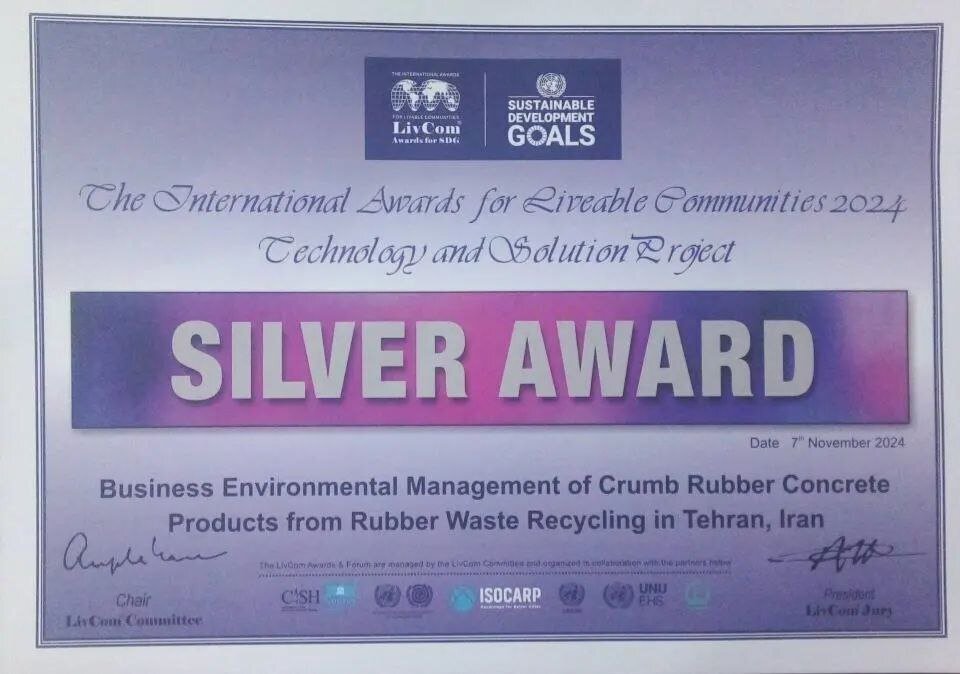Tehran grabs LivCom Award Finals 2024

TEHRAN – The environmental project proposed by Tehran municipality has received the 22nd international award for Liveable Communities (LivCom).
The LivCom Awards Finals 2024 was held in conjunction with the Twelfth session of the World Urban Forum (WUF12) in Cairo, Egypt from November 4-7.
The project, titled ‘Business Environmental Management of Crum Rubber Concert Products from Rubber Waste Recycling’, received the third silver medal in technology and solution project, Mehr news agency reported.
The project competed with 237 other projects submitted by some 57 countries including Germany, the U.S., China, and South Korea, that were invited to Finals.
LivCom Awards were launched in 1997 and is the World’s major Awards Competition focusing on International Best Practice regarding the management of the local environment and development.
The objective of LivCom Awards is to develop and share International Best Practices, with the further objective of improving the living quality of individual citizens through the creation of “liveable communities”.
As a UN-backed Awards Competition, LivCom partners an MOU with the United Nations Environment Programme (UNEP) since 2007, followed by establishing partnerships with multiple UN Agencies and international organizations afterwards.
Iran advances in Environmental Performance Index
The 2024 Environmental Performance Index (EPI) has ranked Iran 113 among 180 countries on climate change performance, environmental health, and ecosystem vitality.
Compared to 2022, Iran’s ranking (133) has climbed up by 20 places. The 2024 EPI provides a data-driven summary of the state of sustainability around the world. Using 58 performance indicators across 11 issue categories, the EPI ranks 180 countries on climate change performance, environmental health, and ecosystem vitality.
These indicators provide a gauge at a national scale of how close countries are to established environmental policy targets. The EPI offers a scorecard that highlights leaders and laggards in environmental performance and provides practical guidance for countries that aspire to move toward a sustainable future.
Iran’s best rankings are in Marine protection stringency (first), Marine key biodiversity areas (KBA) protection (39), Fish stock status (17), Net carbon fluxes due to land cover change (10), Household solid fuels (42), and Waste recovery rate (50).
However, adjusted emissions growth rate for carbon dioxide (162), Lead exposure (156), NO2 exposure (150), Anthropogenic particulate matter (PM)2.5 exposure (140), and Terrestrial Biome protection (145) are among unsatisfactory indices.
Indicators that have had negative trend in 10 years include Adjusted emissions growth rate for black carbon (-64.1), Adjusted emissions growth rate for F-gases (-23.4), Adjusted emissions growth rate for methane (-10.7), Regional marine trophic index (-30.4), Ozone exposure cropland (-28.3), Ozone exposure KBAs (-20.2), and Co exposure (-8.4).
EPI indicators provide a way to spot problems, set targets, track trends, understand outcomes, and identify best policy practices.
Going beyond the aggregate scores and drilling down into the data to analyze performance by issue category, policy objective, peer group, and country offers even greater value for policymakers.
This granular view and comparative perspective can assist in understanding the determinants of environmental progress and in refining policy choices.
MT/MG
